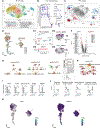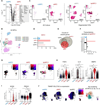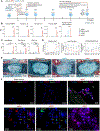Intervertebral disc human nucleus pulposus cells associated with back pain trigger neurite outgrowth in vitro and pain behaviors in rats
- PMID: 38055799
- PMCID: PMC12083434
- DOI: 10.1126/scitranslmed.adg7020
Intervertebral disc human nucleus pulposus cells associated with back pain trigger neurite outgrowth in vitro and pain behaviors in rats
Abstract
Low back pain (LBP) is often associated with the degeneration of human intervertebral discs (IVDs). However, the pain-inducing mechanism in degenerating discs remains to be elucidated. Here, we identified a subtype of locally residing human nucleus pulposus cells (NPCs), generated by certain conditions in degenerating discs, that was associated with the onset of discogenic back pain. Single-cell transcriptomic analysis of human tissues showed a strong correlation between a specific cell subtype and the pain condition associated with the human degenerated disc, suggesting that they are pain-triggering. The application of IVD degeneration-associated exogenous stimuli to healthy NPCs in vitro recreated a pain-associated phenotype. These stimulated NPCs activated functional human iPSC-derived sensory neuron responses in an in vitro organ-chip model. Injection of stimulated NPCs into the healthy rat IVD induced local inflammatory responses and increased cold sensitivity and mechanical hypersensitivity. Our findings reveal a previously uncharacterized pain-inducing mechanism mediated by NPCs in degenerating IVDs. These findings could aid in the development of NPC-targeted therapeutic strategies for the clinically unmet need to attenuate discogenic LBP.
Figures





References
-
- Andersson GB, Epidemiological features of chronic low-back pain. Lancet 354, 581–585 (1999). - PubMed
-
- Frank JW, Kerr MS, Brooker AS, DeMaio SE, Maetzel A, Shannon HS, Sullivan TJ, Norman RW, Wells RP, Disability resulting from occupational low back Pain. Spine (Phila Pa 1996) 21, 2908–2917 (1996). - PubMed
-
- Schwarzer AC, Aprill CN, Derby R, Fortin J, Kine G, Bogduk N, The relative contributions of the disc and zygapophyseal joint in chronic low back pain. Spine (Phila Pa 1976) 19, 801–806 (1994). - PubMed
-
- de Schepper EI, Damen J, van Meurs JB, Ginai AZ, Popham M, Hofman A, Koes BW, Bierma-Zeinstra SM, The association between lumbar disc degeneration and low back pain: The influence of age, gender, and individual radiographic features. Spine (Phila Pa 1976) 35, 531–536 (2010). - PubMed
MeSH terms
Grants and funding
LinkOut - more resources
Full Text Sources
Miscellaneous

